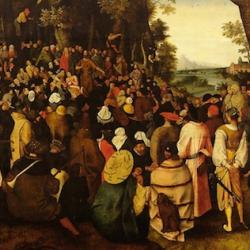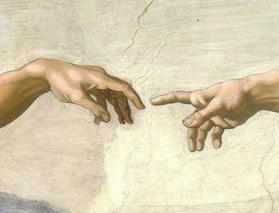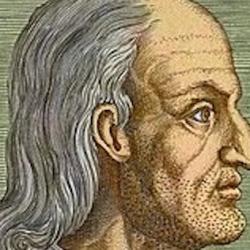Ernst Cassirer ( The Individual and Cosmos in Renaissance Philosophy ) characterizes Nicholas of Cusa as the first modern man in that he focused the concern of philosophy not on God but on “knowledge about God.” In this emphasis, Cusa was making a decisive break with medieval scholastic thought, though one prepared for him by later scholastics. He began with the widely accepted premise that there is not “proportion” between finite and infinite; that is, there is no “measure” or “framework” in which finite and infinite can both fit. To suggest that there is such a proportion reduces the infinite to the finite, and actually makes the “proportion” the new infinite.
Scholastics would agree, but Cusa argued that the form of scholasticism violated this belief: “The content of Scholastic thought contradicts its form; they are mutually exclusive. If the possibility of THINKING the absolute and infinite is to exist, this thought cannot and may not lean on the crutches of traditional ‘logic,’ which can lead us only from one finite and conditioned thing to another, but never take us beyond the domain of finiteness and conditionality.” “Mystical” must replace “rational” theology.
Yet, Cusa is no more satisfied with mystical theology than with scholasticism. He asserts that we cannot love God unless we know Him; we cannot love anything, in fact, without some knowledge of that thing. Further, knowledge of the good spurs the will to seek the good, even though the essence of the good remains inaccessible to us. Hence, “knowing and no knowing coincide. The principle of DOCTA IGNORANTIA as ‘knowing ignorance’ re-affirms itself once again.” Cusa is no skeptic. While denying that the infinite could be knowledge through a concept, there is an “organ” of knowledge that can grasp the infinite, what Cusa calls the VISIO INTELLECTUALIS, in which all the contradictions and tensions of logic are resolved. In contrast to Dionysus, Cusa did not see this vision as an attainment at the end of a series of steps; it is rather attained in a single act, which nonentheless is not a rapture or ecsasy but a movement of the mind. The master form of the visio intellectualis is not “passive contemplation” but mathematics, “which he considers the only true, genuine, and precise symbol of speculative thought and of the speculative vision that resolves contraries. Nihil certi habemus in nostra scientia nisi nostram mathematicam .” Here again, we might observe, Cusa seems to be anticipating particularly modern themes, though he is simultaneously reaching back past Plato to Pythagoras. Mathematical logic thus replaces Scholastic logic, and this is a logic that demands “the possibility of the coincidence of opposites, and requires the convergence of the Absolute-Greatest with the Absolute-Smallest as the firm principle and necessary vehicle of progressing knowledge.”
Cusa stood, Cassirer notes, at the hinge of historical epochs, which, philosophically considered, was concerned with a choice between Plato and Aristotle. Cusa, adopting the philological and historical methods of the Renaissance, set out to untangle Plato from his NeoPlatonic heirs, set them in conflict with each other, and seek a clarification of Platonism in the light of that conflict. Plato’s world was divided between the visible and invisible, separate worlds that were characterized by opposition and contrast. Whatever was true of the visible or sensible world (motion, impermanence, particularity, etc) was the opposite of the truth of the intellectual world (immobility, permanence, universality, etc). KNOWING that there was such a contrast between these worlds was the premise of all genuine knowledge; it WAS knowledge. Anything else could only be opinion (DOXA). To resolve the opposition would destroy knowledge; here, resolution means dissolution. Aristotle had modified Platonism by insisting that however much we may distinguish between different aspects of reality, they are all part of one “unitary dynamic process.” Thus, “development” became the main category for explaining the world. NeoPlatonism’s notion of “emanation,” on Cassirer’s account, is the bastard child of a marriage of Platonic transcendence (the opposition of the forms to the sensible world) and Aristotelian development.
Cusa attempted to reformulate Platonism by seeking to express the relationship between the intellectual and empirical in a different way, using the Platonic concepts of separation and participation. He argued that the “separation” between the finite and infinite cannot be conceived as a purely quantitative difference. It is not possible to move from the empirical to the intellectual through a series of finite steps, so as the reach the “Maximum.” The Maximum is not just a superlative that lies at the end of a series of comparatives, but must be understood to exceed every possible comparative, as “the complete ANTITHESIS to every possible comparison.” Platonic DIFFERENCE cannot be stated more clearly.
At the same time, Cusa also insists equally on participation, and claims that participation and separation are not opposed but mutually necessary. No empirical knowledge is possible except as it is related to “an ideal being and to an ideal being-thus.” Yet, empirical knowledge is not simply knowledge of the truth of the an ideal: “everything conditioned and finite aims at the unconditioned, without ever being able to attain it.” Empirical knowledge is thus true knowledge, but it is also clear that this knowledge is always subject to correction; every measurement will be superceded by a more precise measurement. Empirical knowledge thus remains a “probability,” a “conjecture,” in which “the notion of the eternal ‘otherness’ of idea and appearance is joined with the notion of the participation of the appearance in the idea.” Cusa thus ends with a “negative theology together with a positive theory of experience.”
Thus far Cassirer on Cusa’s epistemology. This analysis leaves me with a vague sense that Cassirer’s Cusa is far less theologically rooted than Milbank’s Cusa.















